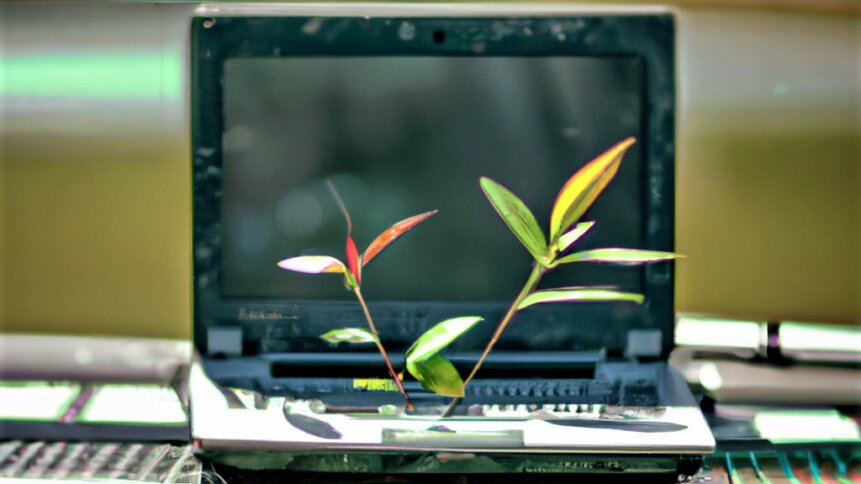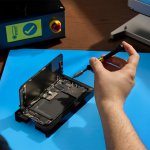Eco-friendly laptops – the environmental rewards of refurbished PCs

|
Getting your Trinity Audio player ready...
|
The prospects for grow-your-own computing are wild based on experiments using slime mold to solve logistics puzzles and building logic circuits out of mushrooms. But fungal processors are in their infancy, and computers are likely to remain works of plastic, metal, glass, copper, gold, and other common electronic materials for some time to come. And this brings us to the challenge of how to make eco-friendly laptops for business and other users.
Tough economic conditions may be cooling the PC market as enterprises lengthen their hardware refresh cycles. But sales of notebooks (a sub-category of ultra-portable laptops) alone still top 200 million annually, based on numbers from Statistica’s Federica Laricchia. And whenever new IT devices are purchased, more environmental costs get baked into the use of computing hardware.
In fact, it’s often said that the best eco-friendly laptops for business are the ones that an organization already has. If there are opportunities to upgrade or refurbish hardware – rather than purchase new equipment – then IT teams should take them. And if companies don’t have the skills in-house there are vendors that can help firms to benefit from electronics that are too valuable to waste.
Laptop remanufacturer Circular Computing gives firms the opportunity to boost their sustainability credentials by purchasing used HP, Dell, and Lenovo laptops that have been made new. The 360-step remanufacturing process includes disassembly, component inspection, remediation, replacement, upgrades, reassembly, and functional testing – to list just a few highlights.
The greenest path to eco-friendly laptops
And if you were thinking that buying a used laptop meant risking disrupting business operations then Circular Computing’s low rate of remanufactured product returns provides evidence to the contrary. Organizations looking into options for eco-friendly laptops will soon see all signs pointing to re-use as the greenest path.
According to the list of case studies on Circular Computing’s website, clients include the WWF, EasyJet, and numerous UK councils. There are cost savings too. Construction firm Balfour Beatty saved over £1 million by purchasing 5,700 remanufactured HP laptops rather than buying new machines. Also, legacy laptops were collected, data erased, and resold to maximize savings.
A refurbished laptop from @fixedlocallyuk and refurbished #Cisco phone for new starter Nick, being installed and delivered to him ready for Monday! Welcome to the team Nick and thanks for sorting out a great eco-friendly laptop solution for him Steve @fixedlocallyuk! pic.twitter.com/xgj0tUkXRk
— O'Brien Media Ltd (@OBrienMediaUK) February 11, 2021
To understand why the numbers are so compelling for equipment re-use, it’s worth looking into the resources required to produce a laptop in the first place. And you might want to sit down for this. The data is staggering. Gathering the resources for just a single laptop requires displacing over a tonne of materials, highlighting the rare earth and precious metals needed for key electronics.
Water use is another issue. Taiwan’s TSMC – the world’s largest independent chip foundry – has a water consumption comparable to the population of a city. But there are caveats. Looking at TSMC’s corporate social sustainability reports highlights how water is reused throughout the process, and the chip giant has introduced additional water reclamation plants to get the most out of each drop.
But those process efficiencies don’t get away from the fact that mining for the metals that go into those chips requires large amounts of water – for example, during extraction and processing. And there are other laptop elements to consider too. Computers can have many plastic components, such as the keyboard and casing. And plastic requires many times its own volume in water for production.
Also, we haven’t mentioned energy yet. Where does the power come from to manufacture the device? There’s also the use of chemicals, although improvements have been made. Back in 2011, Greenpeace highlighted significant reductions in the use of hazardous chemicals [PDF] compared with previous data collected in 2008 and 2009.
Another trend has been improvements in device efficiency. But this doesn’t get away from the fact that 85% of the environmental impact of computing hardware is tied to manufacturing and shipping. Improved energy efficiency doesn’t justify buying another laptop. And older, existing machines could be far more capable than you imagine.
Resist shiny new things, if you can
Running Windows 10 on a 15-year-old laptop is taking things to the extreme. And while Core 2 Duo-based machines are undoubtedly showing their age, even in the hands of expert refurbishers, early models featuring Intel’s i-series of processors still have potential as eco-friendly laptops for business.
For tasks that don’t require high-end graphics processing, companies could save a fortune (and save the planet from the energy and resources required to make a brand-new computer) by repurposing an older laptop. And if Windows is sluggish, there’s the option to run a lighter operating system such as Linux.
This author has been delighted by the performance of a 2016 ASUS ZenBook UX305 that zips along thanks to MX Linux. And if you do need a machine with high-performance graphics capabilities, upgradable second-hand desktop computers will be worth examining before pulling the trigger on a much more expensive laptop.
Extending the lifecycle
Repairability and upgradability are hugely important buying criteria for eco-friendly laptops given that the majority of the machine’s carbon footprint is associated with raw materials and manufacturing rather than use. Right-to-repair advocate iFixit publishes laptop repairability scores for all the devices it tears down for its component replacement guides.
One of the concerns Greenpeace had in its 2011 analysis was that there was very little use of recycled materials in devices. And over the past decade, things have improved with device sustainability becoming a selling point in sales literature. Irish tech firm iameco has shown how sustainable materials such as wood can be incorporated into computing designs to reduce the use of plastics.
Computing giant Dell has a whole section of its website dedicated to being guided by circular principles. And if the vendor can make good on its ambitions to ‘harvest individual components for a second, third or even fourth life’ then it will go a long way to making laptops for business more eco-friendly.
And Dell is by no means alone in the push to reduce the environmental impact of laptops and other computing devices. Lenovo’s path to building a more sustainable future includes using post-consumer recycled materials in 100% of its PC products. There’s also product packaging to consider, and Lenovo writes that it has eliminated more than 3,100 tons of packaging by weight, since 2008.
The Global Electronics Council’s EPEAT ecolabel gives buyers of technology products and services the opportunity to examine sustainable electronics criteria such as materials selection and substance management. TCO certification is another indicator that manufacturers have had their sustainability credentials assessed. And registered users get access to those independently verified results, including % of recycled plastic and many other product details.
Progress too is happening on materials recovery when nothing more can be done with laptops and other electronic devices. On TechHQ we’ve shown how waste electronics is increasingly being viewed as a valuable resource rather than a burden. And it’s easy to see why when gold miners work hard to extract 20 g of the prized buttery yellow metal per tonne of milled ore, while an equivalent amount of electronic waste could yield more than 30 times more treasure for recyclers.
“Only 17.4 per cent of 2019’s e-waste was collected and recycled,” reports the United Nations in its triennial Global E-waste Monitor report, last published in 2020. “This means that gold, silver, copper, platinum and other high-value, recoverable materials conservatively valued at US $57 billion – a sum greater than the Gross Domestic Product of most countries – were mostly dumped or burned rather than being collected for treatment and reuse.”
Working or not, electronic devices are too valuable to waste. We know what has to be done; we’ve just got to do it. And then we’d have plenty of eco-friendly laptops plus the money to buy any spares to make them good as new.










